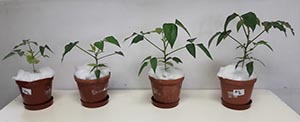Cowpea is an important food legume that is well-adapted to the semi-arid regions of the tropics. The bacteria nodulating cowpea exhibit a large diversity which has been reported in different regions of the world. Little is known about the rhizobia nodulating cowpea in Mozambican soils. In this study ERIC-PCR was used to characterise cowpea rhizobia. This method allowed us to distinguish 20 groups at a similarity level of 20%, indicating a high genomic diversity for the native rhizobial populations in the two agroecological zones. Many reports have shown that there are more rhizobial types in tropical and subtropical than temperate regions. Therefore, studies of rhizobial diversity in tropical environments such as Mozambique could lead to the discovery of diverse rhizobia with interesting traits for use in agriculture.
|
|
Our results are consistent with several studies that found cowpea to be nodulated by genetically diverse rhizobial populations in Mozambique and other African countries (Dabo et al., 2019, Pule-Meulenberg et al., 2010). Furthermore, the fact that some ERIC-PCR clusters were homogenous in terms of the origin of isolates, and others heterogenous suggests that, while the distribution of rhizobial types may be shaped by edaphic and climatic factors, some isolates probably exhibited wider adaptation and could therefore occur in contrasting environments. |
Moreover, the results of 16S rRNA and symbiotic gene phylogenetic trees showed that all the test rhizobial isolates belonged to the genus Bradyrhizobium. Most isolates grouped with B. yuanmingense and B. elkanii, though some clustered with B. icense, B. algeriense, B. vignae and B. japonicum. It has been shown that rhizobial isolates from Mozambican soils shared 100% sequence identity, and were closely related in the 16S rRNA gene tree to B. yuanmingense and B. elkanii (Chibeba et al., 2017). The symbiotic genes phylogenies of isolates (TUTVuIM4, TUTVuIM5, TUTVuAG22, TUTVuAG12 and TUTVuMS1) from AEZ 8 which formed a monophyletic group and could represent a novel symbiovar group of Bradyrhizobium. Another group of isolates (TUTVuIM14, TUTVuIM23, TUTVuIM6) from AEZ 8 close to B. yuanmingense could also be novel symbiovar. Interestingly, all these isolates were obtained from landrace Namuruwa, a highly adaptable landrace in those agroecologies. Results suggested that the native microsymbionts form the best mutual bonding with plants highly adaptable to the environment.
In earlier reports, only sv. glycinearum and sv. tropici symbiovars were reported in cowpea (Tampakaki et al., 2017, Dabo et al., 2019). This study suggests that more diverse symbiovars are responsible for cowpea nodulation in Mozambican soils. In conclusion, this study has revealed that genetically diverse rhizobia belonging to different symbiovars are responsible for cowpea nodulation in Northern Mozambique, thus confirming the promiscuity of this legume. Despite some exceptions, the Bradyrhizobium strains formed many monophyletic groups with the tendency of isolates from a particular agroecological zone to dominate a particular cluster. Another observation is that the cowpea Bradyrhizobium species from Northern Mozambique belonged to the symbiovars glycinearum, sojae and tropici and novel symbiovars.
Acknowledgements
This study was possible through generous financial support from the South African National Research Foundation through the South African Research Chair in Agrochemurgy and Plant Symbioses. We extend our gratitude to IITA-Mozambique, for setting up the experiments and for their assistance with the data collection. A special thanks also goes to the farmers who offered their farms for the experiments.
Margarida Simbine, defended her PhD Thesis in October 2019, at Tshwane University of Technology, South Africa
References
Chibeba, A. M., Kyei-Boahen, S., de Fátima, G. M., Nogueira, M. A. & Hungria, M. 2017. Isolation, characterization and selection of indigenous Bradyrhizobium strains with outstanding symbiotic performance to increase soybean yields in Mozambique. Agriculture, ecosystems & environment, 246, 291-305.
Dabo, M., Jaiswal, S. K. & Dakora, F. D. 2019. Phylogenetic evidence of allopatric speciation of bradyrhizobia nodulating cowpea (Vigna unguiculata L. Walp.) in South African and Mozambican soils. FEMS microbiology ecology, 95, fiz067.
Pule-Meulenberg, F., Belane, A. K., Krasova-Wade, T. & Dakora, F. D. 2010. Symbiotic functioning and bradyrhizobial biodiversity of cowpea (Vigna unguiculata L. Walp.) in Africa. BMC microbiology, 10, 89.
Tampakaki, A. P., Fotiadis, C. T., Ntatsi, G. & Savvas, D. 2017. A novel symbiovar (aegeanense) of the genus Ensifer nodulates Vigna unguiculata. Journal of the Science of Food and Agriculture, 97, 4314-4325.

